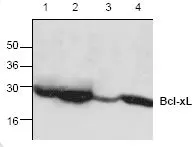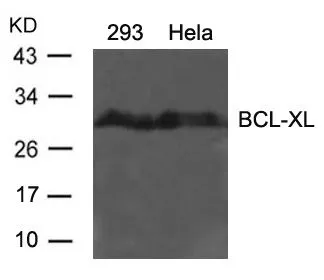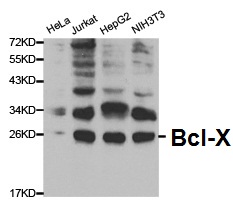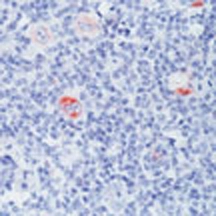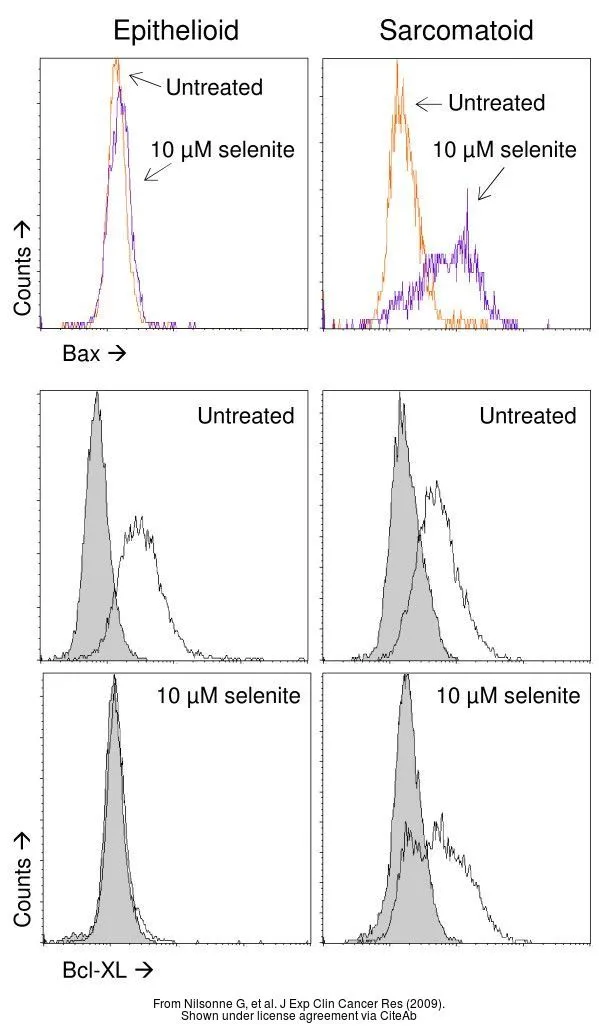
The data was published in the journal J Exp Clin Cancer Res in 2009. PMID: 19563663
Bcl-X antibody [7B2.5] (PE)
GTX46035
ApplicationsFlow Cytometry, ImmunoPrecipitation, Western Blot
Product group Antibodies
TargetBCL2L1
Overview
- SupplierGeneTex
- Product NameBcl-X antibody [7B2.5] (PE) - Orthogonal Validated
- Delivery Days Customer9
- Application Supplier NoteRecommended dilutions: FACS: Use 0.3microg for 10^6 cells. IP: Use at an assay dependent dilution. WB: Use at an assay dependent dilution. Predicted molecular weight: 29 kDa. Not yet tested in other applications. Optimal dilutions/concentrations should be determined by the end user.
- ApplicationsFlow Cytometry, ImmunoPrecipitation, Western Blot
- CertificationResearch Use Only
- ClonalityMonoclonal
- Clone ID7B2.5
- Concentration0.1 mg/ml
- ConjugateRPE
- Gene ID598
- Target nameBCL2L1
- Target descriptionBCL2 like 1
- Target synonymsapoptosis regulator Bcl-X; BCL2L; bcl-2-like protein 1; BCLX; Bcl-X; BCL-XL/S; PPP1R52; protein phosphatase 1, regulatory subunit 52
- HostMouse
- IsotypeIgG3
- Protein IDQ07817
- Protein NameBcl-2-like protein 1
- Scientific DescriptionThe protein encoded by this gene belongs to the BCL-2 protein family. BCL-2 family members form hetero- or homodimers and act as anti- or pro-apoptotic regulators that are involved in a wide variety of cellular activities. The proteins encoded by this gene are located at the outer mitochondrial membrane, and have been shown to regulate outer mitochondrial membrane channel (VDAC) opening. VDAC regulates mitochondrial membrane potential, and thus controls the production of reactive oxygen species and release of cytochrome C by mitochondria, both of which are the potent inducers of cell apoptosis. Alternative splicing results in multiple transcript variants encoding two different isoforms. The longer isoform acts as an apoptotic inhibitor and the shorter isoform acts as an apoptotic activator. [provided by RefSeq, Dec 2015]
- Storage Instruction2°C to 8°C
- UNSPSC12352203
References
- Type I interferon (IFN-alpha/beta) rescues B-lymphocytes from apoptosis via PI3Kdelta/Akt, Rho-A, NFkappaB and Bcl-2/Bcl(XL). Badr G et al., 2010, Cell ImmunolRead more
- Phenotype-dependent apoptosis signalling in mesothelioma cells after selenite exposure. Nilsonne G et al., 2009 Jun 29, J Exp Clin Cancer ResRead more

![ICC/IF analysis of COS7 cells transiently transfected with Bcl-XL plasmid using GTX84834 Bcl-XL antibody [4A9].](https://www.genetex.com/upload/website/prouct_img/normal/GTX84834/GTX84834_1250_ICCIF_w_23061420_378.webp)
![WB analysis of various samples using GTX01535 Bcl-XL antibody [GT1227]. Dilution : 1:1000 Loading : 25 microg](https://www.genetex.com/upload/website/prouct_img/normal/GTX01535/GTX01535_20200508_WB_w_23053121_834.webp)
